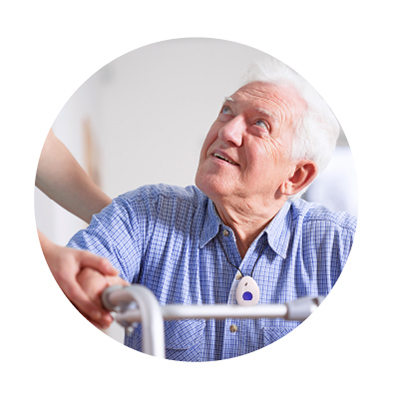Medical Emergency Buttons Offer Quick Help for Strokes

Updated on June 14, 2024
Strokes are difficult to prevent, but if one occurs, literally every second counts. A medical emergency button can summon help fast. The U.S. Centers for Disease Control and Prevention reports that strokes are the third leading cause of death in the United States. Stokes are very much a senior health issue, as more than 75% of stroke victims are over the age of 65.
Strokes occur when blood flow to the brain ceases. There are two main ways this happens.
- Ischemic stroke is when a blood clot or cholesterol blocks off an artery.
- Hemorrhagic stroke is caused by bursting blood vessels.
The National Institutes of Health (NIH) report that some people may be genetically predisposed to weak blood vessels that increase the risk of strokes. Family history of strokes, high cholesterol, diabetes, unhealthy lifestyles, and atrial fibrillation are all known to increase the risk of strokes. An individual's chance of having a stroke also increases as they age.
If you are at risk of having a stroke, wearing a medical alert button is a good idea. These devices can allow you to request help with the push of a button. Additionally, most strokes cause the person to collapse, which can create additional injuries as a result of the fall. Alert1 offers medical alerts with fall detection to help in these situations. Strokes are scary events, but you can increase your chances of receiving fast help with a medical alert system.
Getting Help Quickly is Key
It's important to recognize the signs of a stroke. Getting help quickly is critical for someone having a stroke. The National Stroke Association recommends acting FAST if you observe the following signs:
- Face – can the person smile? Has one side of their face fallen?
- Arms - can the person raise both arms and hold that position?
- Speech - is the person’s speech slurred or are they speaking jibberish?
- Time - time to call for help immediately if you see any of these three signs.
Medical Alerts Summon Emergency Assistance Quickly

Older adults who live alone or are alone for several hours each day should strongly consider an affordable med alert. This device allows individuals to contact emergency services if they experience symptoms of a stroke, or any other emergency-- including non-medical events like car accidents, break-ins, or lock-outs. Help can be reached in seconds at the touch of a button, via a wearable medical alert pendant or wristband, and emergency responders will be able to help even if the individual cannot speak.
The risk of another stroke is highest in the first few months following the first attack, according to the NIH. A medical emergency button can provide added assurance that help can be reached quickly if a stroke victim experiences another attack, is injured in a fall, or needs medical assistance for any other reason. Personal emergency alert systems can bring strong peace of mind to stroke survivors and their families.

